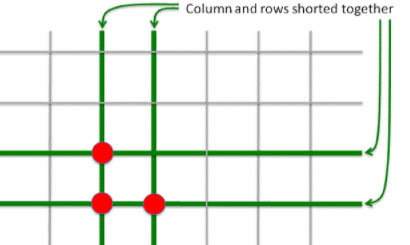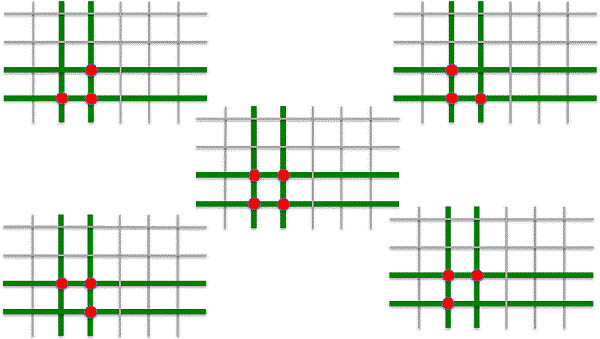What is Keyboard Ghosting?
Keyboard ghosting occurs when a user presses a key, and it does not register. In some keyboards, if you press multiple keys simultaneously, some of those keys don’t work and don’t reflect on the computer screen. Since you did press the keys, but they did not appear on your screen, it means they disappeared and are said to have ghosted. More often than not, keyboard ghosting is a problem faced while gaming. Playing a game often sees you press multiple keys at the same time to perform actions like running while shooting or switching guns while strafing.
What Causes Keyboard Ghosting?
Now we know what ‘ghosting’ means, so the question that arises is why does ghosting happen in the first place. To understand this, we need to take a crash course in how keyboards work. A deep dive into the inner workings of a keyboard is out of scope for this article, but let me explain the basics here. It will enable us to understand why ghosting occurs.
Keyboard Design
Keyboards usually have a grid of column and row wires passing under the keys. These wires are unconnected by default. However, whenever you press a key, the circuit is connected, and the software can figure out which key was pressed based on the connection made. To understand this better, take a look at the picture below. Image courtesy: Microsoft In the image above, the ‘S’ key is pressed. The keyboard can look at which column wire has a row wire connected to it. Once it finds that, it can identify that keypress (in this case, the second column is shorted by the third row, which means you pressed the ‘S’ key). With the same method, keyboards can figure out two-key combinations and even some multiple key combinations without any ghosting. However, let’s take a look at a situation where the keyboard will be unable to find out which keys are pressed.
Pressing Multiple Keys in an Indistinguishable Circuit
In most cases, even with multiple keys being pressed at the same time, keyboards can uniquely identify the key presses. However, certain key combinations can cause keyboards to get confused. Take a look at the picture below where the user pressed three keys, marked with the red dots. Image courtesy: Microsoft In this situation, the way the circuit is completed, the keyboard registers not only three keys presses but also a fourth keypress. The keyboard can identify that row 3 and row 4 keys are pressed in column 2. It can also identify that a row 4 key is pressed in column 3. However, it also seems as though a row 3 key in column 3 is also pressed because the circuit is complete. So basically, the keyboard has no way of figuring out which keys out of these four keys did you press because the following key combinations could all be true. To prevent itself from reporting incorrect key presses, the keyboard stops registering all key presses, resulting in what you know as keyboard ghosting.
What are Anti-Ghosting Keyboards?
So how do we go about solving this fundamental issue with keyboard designs? As it turns out, there are three different steps manufacturers can take to fix the ghosting issues.
Keyboard makers can rearrange the wires in the keyboard so that key combinations that are often used together don’t exhibit these issues. Use extra wires to prevent ambiguity while pressing key combinations. A diode can be used on every key to register them individually.
The first method, though probably the easiest, doesn’t entirely solve the problem. It simply moves the issue of ghosting to a different set of keys, which are likely not used together as often and might go unnoticed. It is the method used in many anti-ghosting keyboards. An anti-ghosting keyboard from Cooler Master The second method, on the other hand, solves the problem. But adding more wires means building more circuitry for the keyboards, meaning the keyboards will be more expensive. Using a diode can also fix the issue, but adding one diode for every key on a keyboard is also very expensive.
All Anti-Ghosting Keyboards are Not Created Equal
Many a time, you will see keyboard manufacturers label their keyboards as ‘anti-ghosting,’ but they are only telling part of the story. In many cases, anti-ghosting keyboards only fix the ghosting issue for key combinations that are often used together. That means the problem remains for other (usually not as common) key combinations. That is fine until you end up using the key combinations that do suffer from ghosting issues, and you realize that your keyboard no longer works.
What is N-Key Rollover? Is It the Same as Anti-Ghosting?
Another term you will often hear when searching for keyboards is n-key rollover. Typically, you would see this on gaming keyboards or even on gaming laptops. So what does N-Key rollover mean? Is it the same thing as anti-ghosting? The answer is no. N-key rollover is different. If a keyboard supports N-key rollover, it means you can press any number of keys on the keyboard simultaneously without any issues. The keyboard will register all the key presses. A BenQ keyboard with N key rollover However, as you might have guessed by now, N-key rollover is pretty much useless without anti-ghosting techniques. A keyboard needs to have anti-ghosting to reliably support simultaneous pressing of any number of keys without any issues or false positives. So yeah, if you’re looking to buy a gaming keyboard, having N-key rollover is something you should look out for. It is especially important if you play games that require you to press multiple keys simultaneously.
Keyboard Ghosting, Anti-Ghosting, and N-Key Rollover Explained
That’s everything you need to know about keyboard ghosting, what it means, why it happens, and how manufacturers can make anti-ghosting keyboards that don’t suffer from the same issues. We also took a look at what N-key rollover means, as well as a quick comparison between N-key rollover vs anti-ghosting keyboards. So we suggest you keep this in mind while buying a gaming keyboard to play games like World of Warcraft, Apex Legends, Call of Duty, Valorant, and other popular titles.




